Psoriasis or scaly lichenIt is a chronic disease that affects the skin and its appendages: nails and hair. It is characterized by periods of deterioration (relapse) and temporary well-being, when the manifestations of the disease are reduced. This disease is not contagious and the patient is not dangerous to others. Because the appearance of psoriasis is not associated with microorganisms.
Psoriasis most often occurs between the ages of 15 and 45 years. People with open skin are more sensitive to it. In developed countries, the number of patients with psoriasis reaches 2-4% of the population. Every 25th inhabitant of the earth on all continents suffers from it.
A large number of medical institutions are dealing with this problem. Therefore, psoriasis is known as the most studied disease. But still, this disease is not fully understood. It is officially considered incurable and raises many questions.
Psoriasis is caused by the body's own immune cells. They rise from the lower layers of the skin to the upper ones, causing inflammation, proliferation of epidermal cells, and the formation of small capillaries.
The manifestations of psoriasis on the skin are quite different. Most often, the disease causes the appearance of red spots - psoriatic plaques. They are dry to the touch, rise above the surface of the skin and are covered with a white layer.
Types of psoriasis
The disease is divided into two major groups: pustular and non-pustular psoriasis.
Psoriasis not pustular
- common (vulgar) or simple psoriasis (plaque psoriasis, chronic persistent psoriasis)
- psoriatic erythroderma or erythrodermic psoriasis
Pustular psoriasis
- pustular psoriasis von Tsumbusch or generalized pustular psoriasis
- palmoplantar psoriasis (pustular limb psoriasis, chronic persistent palmoplantar pustulosis)
- psoriasis pustular ring
- palmoplantar psoriasis
- herpetiformis impetigo psoriatic
In addition, these types of psoriasis are distinguished.
- psoriasis seborrheic
- psoriasis of flexor surfaces and skin folds
- Napkin psoriasis
- drug-induced psoriasis
According to the severity, such forms of psoriasis are distinguished.
- Soft - less than 3% of the skin is affected.
- Moderate - 3-10% of the skin is covered with psoriatic plaques.
- Severe - has joint lesions or is involved in more than 10% of the skin.
Causes of psoriasis

To date, there is no clear answer to the question: "why does psoriasis occur? " Scientists have put forward several theories.
- Psoriasis is an autoimmune disease. It is based on a malfunction of the immune system. Immune cells of T-killers and T-helpers, whose function is to protect the body from viruses, bacteria and tumor cells, for some reason penetrate into the upper layers of the skin. Here they produce inflammatory mediators - substances that "trigger" the inflammatory response. It results in increased skin cell division and proliferation.
- Psoriasis is a disease caused by damage to the growth, division and maturation of epithelial cells - keratinocytes. The result of such changes in the skin is an attack by immune cells of T lymphocytes and macrophages on diseased skin cells.
Factors contributing to the development of psoriasis
Doctors have noticed a number of factors that can cause the onset of the disease. Of course, psoriasis most often occurs if some of these conditions act on the body immediately.
- Hereditary predisposition.There is a version that the genes that are responsible for the immune system and for the function of T lymphocytes are carriers of the disease. Therefore, parents suffering from psoriasis are more likely to have children who exhibit the same symptoms.
- Thin dry skin. . . It has been observed that people with such skin characteristics get sick more often than those with oily and well-hydrated skin. This is probably due to the protective functions of sebum and the structural features of the skin.
- External stimuli. . . A high percentage of patients are among those persons who are constantly in contact with alcoholic solutions, solvents, household chemicals, cosmetics (lotions, hand creams).
- Excessive hygiene- an excessive love for cleanliness also undermines the protective properties of the skin. Soaps, shower gels and cloths wash away the natural protective barrier and leave behind microscopic injuries.
- Bad habits- Addiction to alcohol, tobacco and drugs is bad for the skin. Her diet and blood supply are deteriorating.
- Hiv- Patients with AIDS are more prone to psoriasis. Scientists can not explain this phenomenon. The fact is that psoriasis is caused by increased activity of lymphocytes and with AIDS, their number decreases.
- medications- taking certain medications can provoke illness. Among them: beta-blockers, antidepressants, anticonvulsants and anti-malarial drugs, lithium carbonate.
- Infections (fungus and staph). . . Very often, there were cases when psoriasis appeared immediately after fungal infections or diseases caused by streptococcus.
- Moving- a climate change or even a season of the year, environmental degradation can be the cause of this disease.
- Stress- strong emotional shocks or physical stress (prolonged periods of hypothermia, overheating, accidents) precede the onset of the first symptoms of psoriasis.
- Trauma- Continuous effect on the skin: pressure, rubbing, scratching. Such regular trauma can cause the appearance of the first psoriatic plaques in this place.
- Allergic conditions- Allergic skin rashes and the processes that occur in this case, in all layers of the skin, also increase the risk of disease.
What are the symptoms and signs of psoriasis?
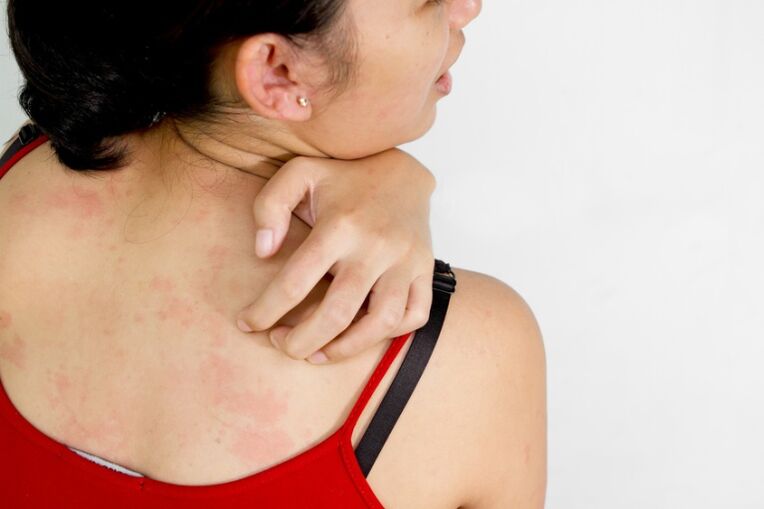
Psoriasis is a systemic disease that affects more than just the skin and nails. Affects the joints, tendons and spine, immune, nervous and endocrine systems.
But still, the main manifestations of the disease occur on the skin. The name squamous lichen accurately conveys the symptoms of psoriasis. The first manifestations are often bright pink or red papules of precisely rounded shape, covered with scales - psoriatic plaques. They are located symmetrically, mainly on the extensor surfaces, in the lower back and on the scalp. But they can affect any part of the skin and genital mucosa. Their size is from a few millimeters, in the initial stages, to ten centimeters or more.
Depending on the characteristics of the rash, suchforms of psoriasis:
- Pit psoriasis - the size of the elements is smaller than the head of a peg.
- Psoriasis guttate - papules are teardrop-shaped and reach the size of a lentil.
- Coin psoriasis - plaques grow up to 3-5 mm and have rounded edges.
They also distinguish forms of blush, when its elements are in the form of rings, bows and crowns, geographical maps with uneven edges.
The papules are covered with a scaly layer that can be easily removed. It consists of keratinized cells of the epidermis. The psoriatic plaques begin to flake off from the center, then the plaque spreads to the edges. Its loose and light appearance is due to the fact that keratinized cells are permeated with air-filled spaces. A pink ring can form around the elements - this is an area of inflammation, an area of plaque growth. The skin around the rash elements has not changed.
Psoriasis of the scalprepresents psoriatic plaques that rise significantly above the surrounding skin. They are densely covered with dandruff-like scales. In this case, the hair remains intact. Rash can appear not only under the hair, but also on smooth skin, on the neck and behind the ears. Such changes are explained by the active division of keratinocytes in the affected areas.
Psoriasis of the feet and palmscauses a strong thickening of the corneal layer of the skin in these areas of the body. The skin becomes thick, rough. Cracks often penetrate it. This is caused by the intense division of cells, which multiply 8 times faster than usual, but are not removed in time from the surface of the skin.
Psoriasis of the nailsvaries in a range of symptoms. But the most important are the two main types of nail plate damage:
- According to the type of "castle". Small holes are formed in the nail plate, similar to the marks of a needle stick.
- According to the type of onychomycosis. The lesions resemble nail fungus. Nails thicken, change color, fall off. A psoriatic papule surrounded by a red edge is visible through the nail plate. It looks like a sack that encloses with a drawstring.
The symptoms and signs of psoriasis depend on the stage of the disease, which replace each other cyclically throughout the year. So most patients have some kind of "winter" disease, when the irritation occurs in the autumn-winter period. An improvement of the condition in summer is for the fact that ultraviolet light in the sun has a therapeutic effect. But some patients suffer from the "summer" type.
There are such stages of the course of psoriasis:
- progressive - the appearance of new elements, the active growth of existing plaques, the implication of the pink growth area around them, skin and intense itching.
- stationary - inhibition of papule growth, absence of new rashes, fine folding of the upper layer of skin around psoriatic plaques.
- regress - lack of peeling, disappearance of plaques and the appearance in their place of pigmentation areas, indicate the softening of the process.
What do skin rashes with psoriasis look like?
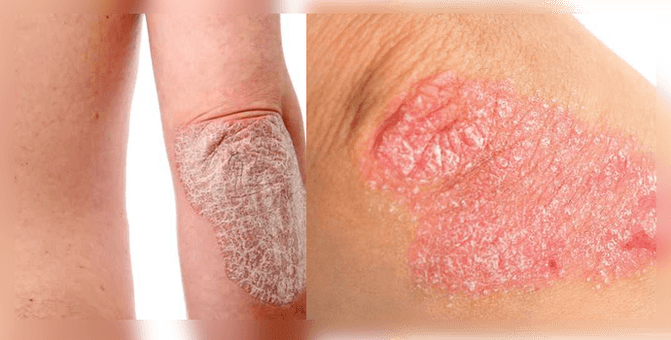
Each organism is individual and reacts differently to disease. Therefore, the nature of the rash can be very different. This explains the variety of forms and types of psoriasis.
However, for most people, the symptoms of psoriasis are similar. These are red spots - psoriatic plaques, which rise 1-3 mm above the level of healthy skin. Their appearance is caused by the fact that the cells of the superficial layer of the skin - keratinocytes, divide very actively, not having time to mature and return to full epithelial cells. As a result of this increased pathological growth, certain areas of the skin thicken. This is due to the fact that immune cells release chemicals that cause inflammation in the skin.
From above, the tiles can be covered with a gray, silver or yellow bloom, which looks like paraffin. Hence, they got the name - "paraffin lakes". These are keratinized epithelial cells, the rejection of which is impaired and they accumulate on the surface of the affected area of skin.
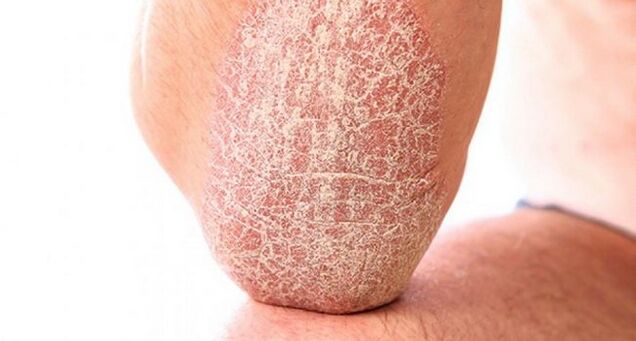
The spots are rounded, hotter than the rest of the skin and can grow to a large size. Often the patient feels severe itching in this place. This is due to the fact that, against the background of the inflammatory process, a cascade of neuro-reflex reactions and an allergic reaction occur.
Another type of element are papules. These are small elements of a rash that resemble a tubercle. The size is about 1 mm. In the middle there is no cavity filled with contents. They are often found at the knee and elbow joints. They remain even during periods when the disease recedes.
During irritations, the blush elements gradually increase in width and join the adjacent plates. During periods of improvement (remission), the spots begin to lighten from the middle. They gradually take the form of a ring and can be completely digested. Behind the tiles, on the body remains a trace - pigmentation. It may be noticeably lighter or darker than the surrounding skin. Once a person is tanned, the skin tone is usually evened out.
What Do Nail Lesions Look Like In Psoriasis?
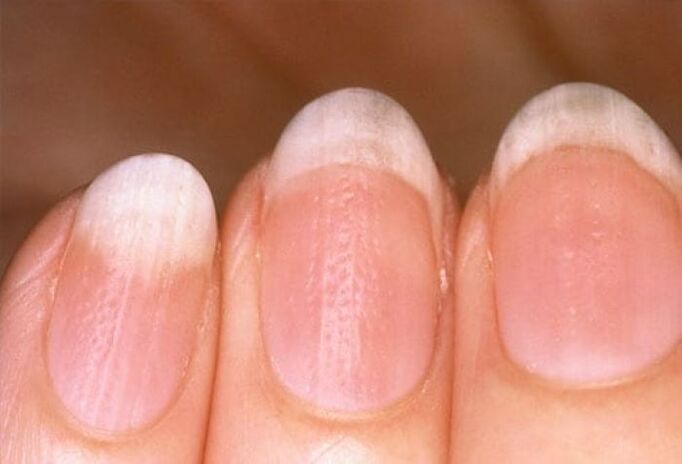
Nail psoriasis is similar to a fungal infection of the nail plate. For an accurate diagnosis, it is necessary to perform a laboratory analysis. The changes can affect only one nail or all at once and are very different. They occur in 10-15% of patients. Nail damage is often associated with joint pain caused by psoriasis. In this case, there may be no skin rash.
Nail psoriasis has several stages:
- desperate points - sheath nail
- printed longitudinal grooves
- transverse compression in the center of the nail, these first signs are associated with damage to the nail root - the nail matrix.
- "Oil stains" pink irregularly shaped spots that appear through the nail - this is the accumulation of serous fluid under the nail
- nail becomes dull, turbid, yellow and thick due to circulatory disorders
- the nail plate takes on the appearance of bird claws, which is accompanied by pain. This is due to the fact that the process captures nerve endings.
Nail lesions start from the edge and gradually move towards the root, covering the entire surface. Microcirculation disorders cause the nail to blur and change its color from yellow to bluish.
If you find similar symptoms in yourself, do not diagnose yourself. Similar changes can be caused by other reasons: fungus, trauma, and impaired blood supply.
Is psoriasis contagious?
This question is often asked by those who have just been diagnosed with the disease and the patient's acquaintances. Scientists give a clear answer to it. Psoriasis is not contagious and a sick person is absolutely safe for others. This is because psoriasis is not caused by a virus or bacteria, but by aggressive white blood cells. These immune cells, for unknown reasons, attack the skin cells, causing inflammation of the skin. The result of this process is redness and thickening of the skin in some places (psoriatic plaques).
How is psoriasis treated?
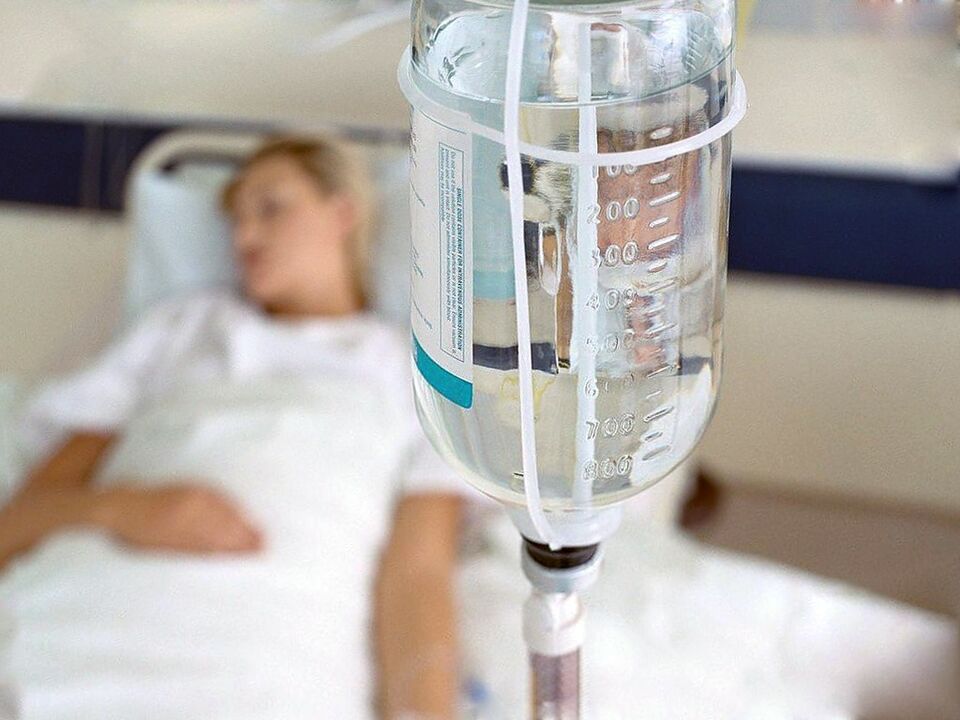
Treatment for psoriasis depends on the form and stage of the disease and the sensitivity to the medication. Traditional medicine focuses on the use of medicines. Treatment begins with topical preparations that act on the affected skin. Thus, they try to avoid the side effects that occur when taking medications by mouth. More details about the use of local remedies will be described below. Now let's dwell on the pills and capsules.
There is a technique when, first, the patient is offered milder medication with the least number of side effects. If they are not effective, they are replaced with more powerful ones, and so on. Even when the treatment is suitable for the patient, after a while he changes. The fact is that the body gradually gets used to the drug and its effect decreases.
Systemic oral medications are very effective. They are prescribed for moderate and severe stages of the disease. They also help those patients for whom treatment with other means has not given a positive result. However, they have significant disadvantages: they can cause serious side effects and after the removal of these funds, the situation worsens again.
| Group of drugs | Dosage form and effect of the drug on the body |
| Retinoids - derivatives of vitamin A. | Affects the maturation of the surface layer of the skin and eliminates the disturbances in this process caused by psoriasis. Release form - capsules. Dosage according to the scheme, depending on the phase, 30-75 mg / day. Reduces the rate of keratinocyte division, promotes normal maturation and cell differentiation. Available in capsules. The daily dose is 25-50 mg. |
| Immunosuppressants - drugs that reduce the activity of the immune system | Reduces the activity of T lymphocytes, which cause increased skin cell division. Sterile solution in ampoules. The initial dose when administered intravenously is 3-5 mg / kg per day, for oral administration - 10-15 mg / kg per day. |
| Drugs for the treatment of malignant neoplasms (Cytostatics) | Inhibits the overgrowth and reproduction of atypical epidermal cells. Available in tablets. Assign 2, 5-5, 0 mg orally, 2-3 times a day, 1 time per week. |
Physiotherapy treatments for psoriasis are very effective. They bring considerable relief to patients, stop the progression of the disease, and, in some cases, serve as a safe substitute for medication.
| Method of physiotherapy | Effects on the body |
| PUVA therapy or photochemotherapy | Combination of long-wave ultraviolet radiation and an internal photosensitizer. The course is 20-30 procedures. The method is based on the fact that UV rays penetrate deep into the skin. The photosensitizer inhibits the DNA synthesis of skin cells and the degree of their division. For treatment, special installations or cabins are used. |
| Selective phototherapy (S. F. T) | Ultraviolet skin radiation with a wavelength of 280-320 nm. The course is 15-35 procedures. A separate therapy cabin is required. |
| Monochromatic UV treatment | Exposure to each focus separately with a laser source or UV lamp. Makes it possible to radiate foci even in hard-to-reach places, without touching healthy skin. Prescribed in cases where less than 10% of the skin is affected. The course of treatment is 15-30 procedures. |
| Laser therapy | Laser radiation of different wavelengths is used to treat rashes. The laser promotes rapid resorption of psoriatic plaques, protects against the appearance of scars in their place. The doctor determines the number of procedures individually for each patient. |
| Elektrosleep | The procedure is performed on a device that is based on a gentle effect on the brain with weak electrical impulses. Duration 20-60 minutes. The number of procedures is 10-12. Elektrosleep has a calming effect. As a result, the activity of the nervous system normalizes, the plaques begin to disperse and a period of well-being begins more quickly. |
| Magnetotherapy | Magnetic field treatment has a beneficial effect on the general condition. Itching and inflammation of the skin, swelling and pain in the joints are reduced, the psycho-emotional state improves. The Betatron device is used for treatment. The duration of the procedure is 20 minutes. Number per course 10-15. |
| Ultrasound therapy | Used as a painkiller, antipruritic and decongestant. Promotes wound resorption. The procedure can be combined with drug administration (phonophoresis). The duration of exposure in one area is 15 minutes. To get a therapeutic effect, 7-14 sessions are needed. |
| Hyperthermia | Heat the fabrics to a temperature of 40 degrees using special pads with a thermal mixture. This effect on the body normalizes the functioning of the immune system and reduces the attack on the skin. The duration of the procedure is about 2 hours. Their number is determined by the doctor. |
| Treatment of bee venom | The substance is introduced into the body using an electrophoresis or ultrasound apparatus. An anti-inflammatory, absorbent, antipruritic effect is achieved. Metabolism is normalized. The minimum number of procedures is 10. |
It is very important that people with scaly lichen follow a diet. Eating disorders can make the disease worse. The menu should be rich in vitamins and at the same time simple. It should give rest to the intestines and liver, and also not cause allergies in the body.
| Allowed Products | Prohibited foods |
| Vegetables (pumpkin, watermelon, beet, carrot, potato, radish) | Animal fats |
| Fruits (apricots, peaches, apples), juices | alcohol |
| Berries (except red berries: strawberries, raspberries, red currants) | Fatty meats (pork, duck) |
| Fresh herbs | Smoked meat |
| Lean meat (beef, beef, rabbit, turkey) not more than 200 g per day | goldfish |
| Cheese, cottage cheese, dairy products | Fizzy drinks and coffee |
| nuts | egg |
| Low fat fish varieties | Ice cream and milkshakes |
| Seaweed | Minimum amount of sweets and sugar |
| Black bread | Butter and sulfur dough |
To cleanse the body of toxins and metabolic products, it is necessary to fast days twice a week. They recommend kefir, apples, vegetables.
Which ointments are effective in treating psoriasis?
The use of ointments for psoriasis brings the greatest effect compared to other external preparations. The oil ingredients do not stick to the surface of the plaque, but soften the scales and penetrate inside the skin.
There are a large number of ointments available for treating psoriasis. In the first stages, assignnon-hormonal ointments.
In case the treatment did not give the expected effect, then describehormonal ointment. . . Treatment begins with lighter drugs that have minimal side effects. If improvement is not achieved, then stronger glucocorticosteroid ointments are prescribed.
| The name of the oil | Drug action | Side effects |
| Weak ointments | Suppresses the increased activity of leukocytes, prevents their movement in the skin, eliminates the feeling of tightness and itching. | Swelling of the skin, itching, redness. |
| Moderate ointments | Has anti-inflammatory, anti-allergic, anti-edematous, antipruritic effects. Suitable for patients with exudative forms of psoriasis, reduces bleeding. Apply in a thin layer on limited areas 2-3 times a day. The treatment lasts 10-14 days. | Steroid acne, atrophy and stretching of the skin, burning, itching, hypopigmentation. |
| Strong ointments | Local anti-inflammatory, antipruritic and anti-allergic agent. Reduces skin moisture. Apply to the affected area 2-3 times a day for up to two weeks. Used during an irritation. | Skin atrophy. |
| Very strong ointments | Has a strong antipruritic and anti-allergic effect. Slows down the processes of cell division and keratinization. Apply 1-2 times a day for no more than two weeks per course. | Acne, hair loss, skin atrophy. Do not use for pustular and plaque psoriasis. |
Pharmaceutical companies produce many medicines in the form of ointments. The doctor individually selects the medicine for the patient and, if necessary, changes it to a stronger one.
Remember that in no case with psoriasis should you ignore doctor visits. After all, this disease can hide the initial stage of skin cancer.
Choosing a treatment regimen for psoriasis is a long process that involves many trials and errors. Do not despair if you do not immediately find "your" medicine. Remember that many people achieve lasting improvement when the disease does not return for years. You can do it too!























